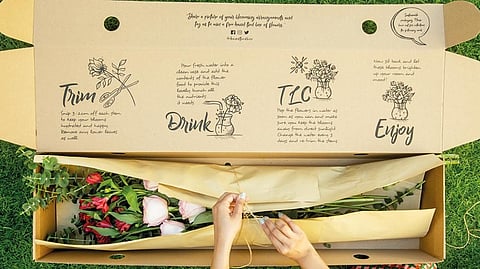DIY flower designs: the florists who want you to style your own blooms
Today, you can be your own Valentine. Preeta Sharma and Aishwariya Ravi, founders of Hand-Tied, a sustainable floral subscription service that delivers a box of fresh flowers to you (or a loved one), tell why waiting to be bought flowers is passé

Tell us a little about how Hand-Tied bloomed to life.
Preeta: A few months ago I realised how much I enjoyed the relaxing and meditative powers of bringing flowers home. That’s when Aishwarya, a family friend, and I joined forces and decided, ‘why wait for special occasions or for someone to buy you flowers?’ It’s 2020 and buying yourself flowers should be seen as an act of self-love.
So you handpick them, tie them up and ship them over. Then?
People assume that you should take a floristry class or have some sort of professional background to make your own arrangements, but that’s a myth. We provide a step-by-step step guide on how to arrange your blooms. We’re pretty sure that after a while, all our subscribers would have mastered the art themselves.
So fashioning a bunch of flowers into Instagrammable nosegays and posies becomes a cakewalk?
There are countless styles when it comes to arrangements. However the arrangement style we’re basing the instructions on are more on the lines of minimal with a hint of loose and wild, which allows you to add a bit of your personality to the arrangement.
What were the two of you doing before you launched Hand-tied?
Preeta: I’m an engineer who worked in the oil and gas sector for over 10 years, after which I threw in the towel and decided to explore Europe and worked for a women’s charity that really shaped my thoughts and gave me the strength to jumpstart my creativity.
Aishwariya: My education and experience have been around advertising and digital marketing but I grew up learning about flowers and floristry since it has been my family business for the last 25 years. So, Hand-Tied has been a great mix of both the worlds.
The farm-to-table concept is quite intriguing – where do you procure your flowers from and how?
We want to bring nature indoors but consciously and sustainably, which is why we source our flowers from sustainable farms across Europe and East Africa; we have shipments coming in every day to guarantee freshness. At times we look into regional wholesalers too. We’re hoping down the line we can avoid the middlemen and have all our long-lasting flowers arrive directly to us in bud form.
In what way do regular flower bouquets have a negative environmental impact?
Unlike a traditional flower shop, we don’t have flowers lying around for days. Cut flowers last, at most, ten days after being cut. So unused or old flowers can contribute to waste.
And how does Hand-Tied overcome this?
We only use the exact number of flowers needed to serve our community thanks to the subscription model. The boxes also packed full, which allows subscribers to create more than two arrangements at times. We also try hard to include only seasonal flowers along with a care and arrangement guide and flower food, so the blooms last longer. Plus, our boxes are reusable (and recyclable) and we encourage customers to leave them out for collection for the following week’s deliveries.
Tell us a bit about your subscribers.
A majority of our customers subscribe to plans for themselves and believe in treating themselves but we also have customers who want to make their loved ones feel special all month long. Lots of children have sent their parent’s weekly plans and it’s a delight to see fathers being gifted flowers too.
How do flower arrangements fit in with the current self-care fixation?
Our boxes offer people the chance to disconnect from the distractions and pressures of daily life – personally for me, it’s reduced my endless scrolling through social media. In fact, flower arranging is one of the oldest art forms and is a highly effective therapeutic and meditative process – some of our arrangements come in mixed with foliage like eucalyptus leaves. It’ll take you about 15 minutes, and those are 15 minutes where you can mindfully connect with nature (in the comfort of your own home) and be present. Especially in apartments where green spaces or even balcony gardens are hard to maintain.
Convince us that hand-making a bouquet trumps professionally arranged ready-to-buy bouquets for Valentine’s Day.
The same old roses arranged in a bouquet the same way year-after-year can get boring. You get to arrange flowers in a way that best represents your love along with different kinds of flowers. Plus, you’ll get brownie points for effort.
Is it a myth that only roses convey romance?
Absolutely right. As classic as [roses] are, every relationship has a different love language that can be expressed through different flowers. Besides the quintessential red roses, you can use arrangement featuring pink lilies, blush garden roses and citrusy wax flowers and mophead hydrangeas are the star of the other one.
What flowers are currently in season?
As we’re at the end of winter, we’ve been enjoying some amaryllis, alstromerias, statice and brassicas. Spring will bring in tulips, peonies and ranunculus.
Your favourite flowers, and why?
Preeta: I’m always torn between yellow tulips and hydrangeas; I love tulips for their vibrant simplicity and hydrangeas for their beauty, size and versatility – they’re easy to style, pair well with any flower or foliage.
Aishwariya: I’d have to say hydrangeas too. They’re lush, elegant and make for great arrangements on their own. I also love peonies for their regal look.
Visit: www.handtiedbox.com
Sign up for the Daily Briefing
Get the latest news and updates straight to your inbox



